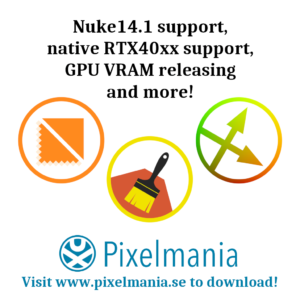This is an across the board maintenance release where we are focusing on compatibility and stability. All plugins now support:
- Better automatic releasing of used GPU memory after processing has finished. Also, you no longer need to restart Nuke to release all memory, just do a “File / Clear”
- Added support for Nuke 14.1
- Added support for CUDA 11.8 and hence native Ada Lovelace/Hopper compatibility, e.g. RTX40xx GPUs
- We have nailed down a few edge case bugs that led to crashes
- Better info about JIT-compilation and CUDA compatibility
- Better error logging (telling you if you are running out of GPU VRAM more clearly)

NNSuperResolution v3.4 does in addition to all the above, support single channel layers and has been internally optimized to perform about 20% faster in sequence mode! The full change log can be found here.
NNCleanup v1.4 is in addition to the list above, also featuring four new neural network variants (AA-DD), with improved detail and color stability. The full change log can be found here.
NNFlowVector v2.2 is including the full list of changes above, but haven’t got any other extra changes. The full change log can be found here.
This release is so far only for the Linux builds of the plugins, sorry about that. We decided that it was better to get this release out to the public as soon as possible, and then continue the work with creating the Windows builds (instead of just sitting on the Linux builds for some undetermined amount of time) . It’s hard to tell exactly how long it will take to create the Windows builds, but a likely estimate is before the end of January (but hopefully earlier!).
If you are unsure of what CUDA version of the different builds that you should download and run, please have a look at our new CUDA compatibility chart page.
To follow up on the last blog post; We are still very much working on NNSuperResolution v4.0, but it has turned out that our initial estimate of the needed training time for the new upscale network (with the internal optical flow solution from NNFlowVector) was pretty far off. Instead of a couple of weeks for one of the more complex training stages, it has turned out that it needs to number crunch for a couple of months(!) instead. This is mainly due to the need of a much higher resolution of the training patches since the new optical flow network needs a larger spatial coverage to work correctly. Hence we need to push the time table for getting NNSuperResolution v4.0 released to some time this spring, instead of the end of this year as previously communicated. The one who waits… 🙂
Hope you like these new versions as much as we do!
Cheers, David